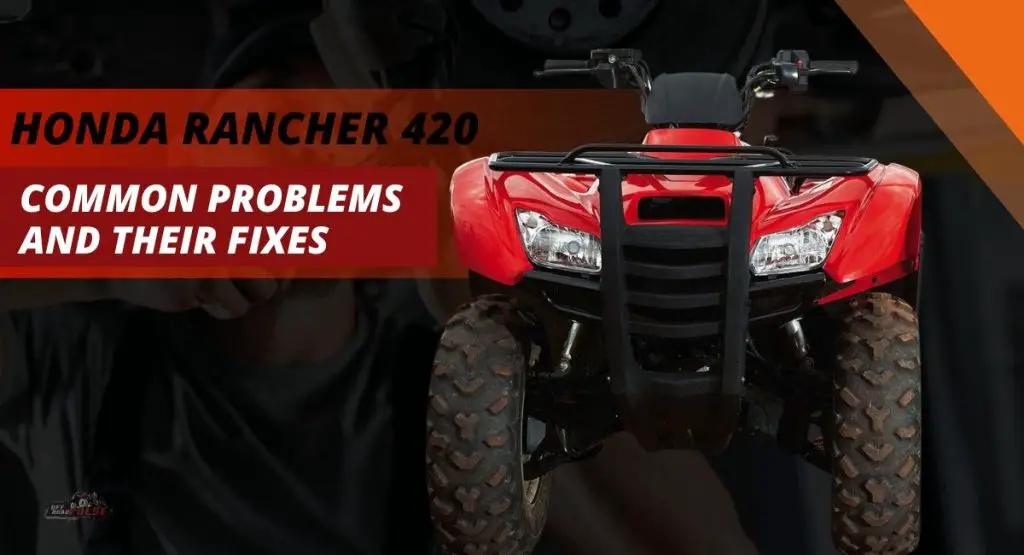The Honda Rancher 420 was first introduced in 2007 and is generally a popular choice for people who enjoy off-road riding. The Rancher 420 is known for its durability, easy handling, and comfortable ride. It is equipped with features like electric power steering, independent suspension, and a selectable 4WD system.
What’s more, Honda has a reputation for producing high-quality products, which helps deliver peace of mind to potential buyers. But like any vehicle, Honda ATVs can experience problems from time to time. Some users have noted limitations in power and suspension, as well as minor drawbacks such as a small fuel tank and engine noise.
It’s important to note that not all Honda 420 models will experience issues, and regular maintenance and upkeep can help prevent or mitigate any problems that do arise. So, if you are experiencing issues with your Honda 420, it’s always a good idea to consult with a certified Honda dealer or mechanic to diagnose and address any problems.
Read Also: Honda Pioneer 520 problems and solutions
Honda Rancher 420 Specs (2023 Model)
| Engine | Displacement- 420cc Type- Single-cylinder four-stroke Cooling- Liquid Bore And Stroke- 86.5mm x 71.5mm Starter- Electric Valve Train- Valve Train |
| Drive Train | Clutch- Automatic Transmission- Five-speed manual with reverse Driveline- Direct rear driveshaft |
| Suspension | Front Suspension- Independent double-wishbone/ 6.7-inch travel Rear Suspension- Swingarm with single shock/6.7-inch travel |
| Brakes | Front Brakes-Dual 190mm discs Rear Brakes- 160mm sealed mechanical drum |
| Tires | Front Tires- 24 x 8-12 Rear Tires- 24 x 10-11 |
| Dimensions | L x W x H- 82.8 x 47.4 x 46.2 inches Wheelbase- 50.0 inches Seat Height-33.7 inches Ground Clearance-7.1 inches Fuel Capacity- 3.9 gallons Turning Radius- 9.2 feet |
Honda Rancher 420 Review
The Honda Rancher 420 is a reliable and versatile ATV that can handle a wide range of tasks and terrains. Here are some selling points and potential drawbacks of this machine;

Pros
Dependable and reliable- Many users praised the Honda Rancher 420 for its durability and long-lasting engine. The Rancher 420 is powered by a liquid-cooled, fuel-injected 420cc engine that delivers smooth and reliable performance.
Versatility- The Rancher 420 can be used for a wide range of tasks, from farm work to recreational trail riding.
Easy to operate- The Rancher 420 features an automatic transmission, making it easy for new riders to operate. This model comes with a five-speed transmission with reverse, providing ample power and control in various terrains and conditions.
Comfort and convenience- The Rancher 420 features a comfortable seat, ergonomic controls, and a digital display that shows speed, fuel level, and other vital information. The seat is comfortable and ergonomically designed for a smooth ride.
Superior suspension- The suspension system of this ATV provides ample ground clearance, allowing the ATV to navigate over obstacles with ease. Additionally, the ATV also features hydraulic disc brakes on all four wheels for excellent stopping power.
Good value- For the price, the Rancher 420 is considered a good value for its features and capabilities.
Cons
Limited power- Some users found the Rancher 420 to lack power when climbing steep hills or carrying heavy loads.
Rough suspension- Although its suspension is still efficient, it is not as smooth as some other models. This often results in a bumpy ride.
Small fuel tank- The fuel tank on the Rancher 420 is relatively small, which may require more frequent refueling on longer trips.
Noise- Some users found the engine noise to be somewhat loud and distracting.
Honda Rancher 420 Top Speed
The top speed of a Honda Rancher 420 depends on various factors such as terrain, rider weight, and modifications, but in stock condition, it can reach a top speed of around 50-55 mph miles per hour. However, it’s important to note that we don’t recommend you ride this ATV at its top speed as it can be dangerous and increase the risk of accidents. Always follow safety guidelines and drive at safe speeds for the terrain and your riding conditions.
Honda Rancher 420 Common Problems
The Rancher 420 won’t start
Starting issues are not uncommon on Honda Rancher 420, just as with any other type of ATV. If the ATV is not used regularly, left sitting for extended periods, or not properly maintained, starting issues may occur from time to time.
There have been many reports of starting issues with the Honda Rancher 420, and it is a widespread problem. Some of the most common causes of starting issues include a dead battery, a faulty starter, a clogged fuel filter, or a dirty carburetor. It’s also possible that there could be issues with the ignition switch or the spark plug.
Solutions
If your Honda Rancher 420 won’t start, there are several things you can check to identify and fix the problem. Here are some common causes of starting issues on this ATV and what you can do to address them;
- Dead battery –A dead battery is one of the most common reasons this ATV won’t start. Check the battery voltage with a multimeter, and if it’s low, try charging it. If the battery won’t hold a charge, it may need to be replaced.
- Bad starter motor- If the battery is fully charged, but the starter motor doesn’t turn over, it could be a sign of a bad starter motor. Try tapping the starter motor lightly with a hammer to help free up any stuck brushes or gears. If this doesn’t work, you may need to replace the starter motor.
- Clogged fuel system- If the ATV has been sitting for a while, the fuel system may be clogged with old gas or debris. Try cleaning the carburetor and fuel filter to see if this solves the problem.
- Faulty spark plug- If you notice that the engine turns over but doesn’t start, a faulty spark plug could be to blame. To solve the problem, you can start by inspecting the spark plug, and if they are worn or damaged, you may want to replace them.
- Faulty ignition switch- If the ATV doesn’t even turn over when you turn the key, it could be an issue with the ignition switch. Check the connections to the switch and make sure they are clean and secure.
Honda Rancher 420 fuel injection problems
Fuel injection problems on the Rancher 420 can take various forms and may have different causes. For instance, if your machine is difficult to start or won’t start at all, it may be due to fuel injection problems. The most common reason behind this problem is a clogged or faulty fuel injector. Consequently, the fuel pump may struggle to deliver fuel properly, or the fuel pressure may be too low.
Similarly, if your Rancher 420 idles poorly or stalls when idling, it may be due to a malfunctioning fuel injection system. Other common symptoms of fuel injection problems that can manifest on this ATV include occasional power loss, rough riding, and poor fuel economy.
Solutions
- Check for error codes- The fuel injection system on the Honda Rancher 420 is equipped with a diagnostic system that can detect malfunctions and display error codes. You can check these codes by using an appropriate diagnostic tool or by taking your vehicle to a Honda dealer for service.
- Check the fuel injectors- The fuel injectors are responsible for delivering fuel to the engine. If they become clogged or damaged, they may compromise the entire fuel system. If you find that the injectors are dirty or clogged, you may need to clean or replace them.
- Inspect the fuel system- Make sure that there is enough fuel in the tank and that the fuel pump is working properly. Also, check for any clogged or dirty fuel filters that might be restricting fuel flow.
- Check the electrical system- Fuel injection systems require a steady supply of electricity to function properly. Check the battery, spark plug, and ignition coil to make sure that they are all working correctly.
- Inspect the condition of the throttle body- The throttle body is responsible for controlling the amount of air that enters the engine. If it becomes dirty or clogged, it can cause fuel injection problems. In addition, ensure to clean the throttle body or have it serviced if necessary.
Honda Rancher 420 electric shift problems
The electric shifting system offers several benefits over traditional manual shifting using a foot lever. The shifter allows the rider to shift gears using buttons or a switch rather than a foot lever, making it easier to shift, especially in tight spots or when wearing bulky riding gear. Electric shifting also helps to reduce rider fatigue by eliminating the need for repeated foot movements to shift gears.
The electric shift system relies on a complex network of wires, connectors, and switches to function. Any issues with these components can cause the system to malfunction. Loose or corroded connections, damaged wires, and faulty switches are also common culprits.
The shift motor is a critical component of the electric shift system, and if it fails, the system will not be able to shift gears. A faulty shift motor can be caused by a variety of issues, including worn brushes, a burned-out coil, or damaged gear. Additionally, if the battery voltage on the ATV is low, the electric shift system may not function properly. This is because the shift motor requires a certain level of voltage to operate correctly.
Solutions
If you’re experiencing electric shifting problems on your Honda Rancher 420, there are several steps you can take to troubleshoot and fix the issue. Here are a few suggestions;
- Check the battery- Make sure the battery is fully charged and in good working condition. Low battery voltage can cause electric shifting problems. In addition, inspect the wiring and connectors for damage, loose connections, or corrosion. If you find any issues, repair or replace the damaged components
- Inspect the fuses- Check the fuses in the fuse box to ensure they are not blown. If you find any blown fuses, replace them with new units with same amperage rating.
- Replace the shift angle sensor- The shift angle sensor tells the ECU what gear the ATV is in. If this sensor is faulty or out of adjustment, it can cause shifting problems. To test the sensor, you can use a multimeter to check the resistance at the sensor’s connector. If the resistance is out of spec, then it may be time to replace the sensor.
- Check the shift motor-The shift motor is responsible for moving the transmission into the correct gear. If the motor is faulty, the electric shifting system will not work correctly. To test the shift motor, you’ll just need to use a multimeter to check for continuity between the two motor terminals. If there is no continuity, the motor is faulty and needs to be replaced.
- Check the ECU system- If none of the above steps solve the problem, there may be an issue with the ECU. You can use a diagnostic tool to check for error codes and identify any issues with the ECU. If the ECU is damaged or faulty, you may need to replace it.
Occasional overheating problems
Overheating can cause serious damage to the engine and is often caused by a malfunctioning cooling system. In most cases, this can be due to a faulty water pump, radiator, or thermostat. In addition, if your coolant levels are low or the coolant is dirty or old, it can also make your ATV overheat.
The water pump is responsible for circulating coolant throughout the engine. If the water pump fails, the engine will overheat. Similarly, if the radiator is clogged or damaged, the engine won’t be able to dissipate heat effectively.
Ideally, overheating can cause serious damage to the engine if not addressed promptly. Regular maintenance and timely repairs can help prevent serious engine problems and extend the life of your vehicle.
Solutions
- Check the coolant level- Make sure the coolant level is at the correct level. If it’s low, add more coolant and check for any leaks in the system. Similarly, if the coolant is dirty or old, it can cause the engine to overheat. Drain the coolant and replace it with a fresh mixture of coolant and water.
- Clean the radiator- Check the radiator for any debris buildup or damage. If it’s dirty, use a soft brush to clean it or take it to a professional radiator cleaning service.
- Inspect the condition of the water pump- The water pump is responsible for circulating the coolant throughout the engine. If it’s not working properly, the engine will overheat. You may also need to check the water pump for leaks or damage.
- Check the fan- The fan helps to cool the engine by blowing air over the radiator. Make sure the fan is working and replace it if necessary.
- Troubleshoot your thermostat- If the thermostat is stuck closed, it will prevent the coolant from circulating through the engine. Check the thermostat for any issues, and if it is faulty, consider getting a replacement.
Suspension system issues
Over time, the suspension of the Honda Rancher 420 may sag due to wear and tear or carrying heavy loads. This can lead to poor handling and increased wear on other components of the vehicle. If you feel like your Rancher 420 is bouncing around or riding rough, it could be due to worn-out shocks or suspension bushings.
Uneven tire wear can also be a sign of suspension problems on the Honda Rancher 420. Generally, if your ATV is not aligned correctly, it can cause one or more tires to wear faster than others. Other common symptoms of suspension system issues include noises/squeaks, rough rides, and frequent bottoming out.
Solutions
- Replace the shocks- Check the condition of the shocks and look for signs of damage or wear. If the shocks are leaking oil, they need to be replaced. If they appear to be in good condition, check the preload settings and adjust them as needed.
- Check the alignment- Make sure that every component of the suspension system is aligned properly. If they are not, they can cause the suspension to feel stiff or loose.
- Adjust the spring preload- Adjusting the spring preload can help improve the suspension’s performance. Check your owner’s manual for instructions on how to adjust the preload.
- Check the tire pressure- Make sure the tire pressure is set to the required levels. Low tire pressure can cause the suspension to feel stiff.
- Consider upgrading the shocks- If you frequently ride on rough terrain or carry heavy loads, you may want to consider upgrading your shocks to improve the suspension’s performance.
Read Also: How to adjust ATV shocks without a tool
Parting Shot!
The Honda Rancher 420 is designed for both recreational and utility use and is suitable for a variety of terrains, including trails, fields, and woods. The machine is built to last, and owners report using their Rancher for years without any major issues.
However, some owners report that the Honda Rancher 420 may develop several issues along the way. This can be frustrating and can take away from the overall riding experience. Luckily, most of these issues are relatively easy to fix, especially for those with some mechanical knowledge and experience working with ATVs.




